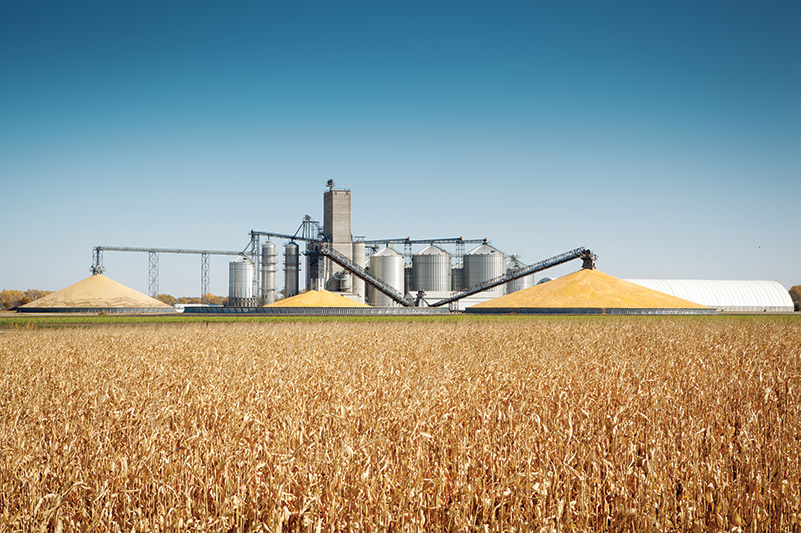From the grain seeds planted in the field to the fuel pumped into your gas tank, new evidence proves the environmental benefits of bioethanol and provides a roadmap to net-zero liquid fuels.
A new peer-reviewed study published in early 2021 shows bioethanol produced today has 46% fewer greenhouse gas (GHG) emissions than regular gasoline, and there’s an opportunity for even more significant improvements as we look ahead.
Environmental Research Letters published the new report, authored by a team of scientists at Environmental Health & Engineering (EH&E), which provides an updated carbon intensity (CI) score of corn-based bioethanol. The report offers further research into the impact biofuels can have in immediately reducing emissions that contribute to climate change and unhealthy air.
Updated Research
Despite all the talk these days about climate and carbon, the modeling on bioethanol had not been updated for a long time. “For years, we’ve known we’re not getting a fair score for the environmental and health benefits of bioethanol,” said Doug Berven, Vice President of Corporate Affairs at POET.
Researchers from EH&E reviewed life cycle analysis (LCA) modeling and consulted with more than two dozen experts in academia, government, and nonprofit organizations to calculate the most comprehensive and up-to-date carbon intensity score (CI) for corn starch bioethanol in more than a decade.
An LCA calculates the greenhouse gas impacts of each stage of bioethanol production and use—from field to freeway. “The study was a comprehensive analysis of every input into the bioethanol production process. We wanted to quantify the carbon intensity at each level to set a baseline and determine where we’re doing well and where we can improve in the future,” said Berven.
The peer-reviewed results dispel many commonly repeated misconceptions about biofuels’ overall sustainability by providing a current, comprehensive and accurate picture of bioethanol compared to conventional gasoline today.
Conclusions
As noted earlier, the updated LCA modeling and emissions data show the CI score for corn bioethanol is 46% lower than conventional gasoline today. The previous USDA modeling suggested the CI score for bioethanol to be 39-43% lower than gasoline.
“The analysis compared several studies and their inputs and found many inconsistencies in previous models which had minimized the actual benefits of bioethanol and agriculture,” said Berven.
The findings reflect a 50% decrease of CI estimates for bioethanol since 2009, attributed to land-use change (LUC) model improvements, greater efficiencies in bioethanol production, reductions in fertilizer application and fuel consumption, and corn yield increases.
“One of the most common misunderstandings many people have is about agriculture’s impact on the environment. This study showed that farmers are a solution in the fight against climate change, and they continue to improve every year,” said Berven.
A dramatic improvement in the CI score was due to updated modeling for LUC, which previously accounted for a large portion of bioethanol’s CI score.
EH&E’s assessment showed carbon emissions from converting prior land uses to corn farming make up only 3.9% of biofuel’s total GHG emissions—a much smaller amount than generally recognized. The 25-fold reduction in LUC since 2008 is due to better data inputs for LUC modeling that consider both the economic value and productivity of cropland.
Previous models assumed new land would be cleared in response to an increase in the price of corn. This assumption has been proven to be false by extensive data on corn production and price over time.
“Early on, many believed that diverting grain for bioethanol production would cause significant land-use change. In reality, the biofuels industry only soaked up surplus grain and had minimal--if any--land-use change impact, and the empirical data proves that,” said Berven.
Low-Carbon Policy Programs
As more lawmakers at the state and federal level join the fight against climate change with transportation policies to reduce GHG emissions from passenger vehicles, policymakers must have accurate, evidence-based conclusions for available fuel sources. “In light of the United States’ renewed effort to achieve a net-zero carbon economy, our research team believes this critical review is a timely contribution to establishing an accurate, common understanding of the GHG profile for corn bioethanol in comparison to gasoline refined from crude oil,” stated David MacIntosh, EH&E Chief Science Officer and Adjunct Associate Professor of Environmental Health at Harvard’s T.H. Chan School of Public Health. The study highlights bioethanol’s clean fuel policy opportunities to help shift the U.S. away from fossil fuel dominance to cleaner fuel alternatives.
“Future policy, whether it’s a low carbon fuel standard or other programs, needs to be based on scientific reality rather than hypotheses,” says Berven. “The reality is biofuels are immediate, affordable and clean and need to play a much larger role in the future.”
Net-Zero Renewable Fuel of the Future
There are nine emissions categories associated with the LCA of bioethanol: farming, coproduct credit, fuel production, land-use change, rice methane, livestock, fuel and feedstock transport, denaturant and tailpipe emissions.
Some of the most significant opportunities to further decrease bioethanol’s CI score are possible through further advances in farming technology and bioethanol production.
“The results of this research are timely for the scientific, public health, legislative and business communities seeking to establish a net-zero carbon economy while addressing related technological, political and economic challenges,” says MacIntosh.
GHG impacts associated with farming consider both on-farm emissions, such as fossil fuel use and soil disruption, as well as those associated with supply chains, such as fertilizer production. Bioethanol LCA models have shown a steady decline in the CI score for corn farming attributable to decreased energy and fertilizer use which are the largest components of GHG emissions for growing and harvesting corn.
As farmers continue to adopt innovative and climate-smart practices like precision agriculture, they will see economic and environmental benefits. According to the study, the CI score for corn produced from states in the upper Midwest, which supply the bulk of the corn to bioethanol production, could be reduced in the region by up to 74% by adopting conservation tillage, reducing nitrogen fertilizer use and implementing cover crops.
“Even small improvements in agriculture can lead to major benefits for the environment, and biofuels play a role in incentivizing those improvements,” says Berven.
Likewise, bioethanol producers have an opportunity to reduce the CI score further by exploring alternative energy sources like wind, solar and biogas, sequestering carbon and expanding the production of coproducts like corn oil. With simple adjustments, bioethanol production could deliver a net carbon sink over a much shorter period than previously estimated.
“We’ve come a long way, and there is more opportunity to continue to decarbonize,” said Berven. “One of the most exciting things about the study is that not only are we 46% cleaner than gasoline; we have the potential to be a net-neutral or net-negative fuel in the near future, meaning not only are we not contributing GHGs, we’re reducing the CO2 in the atmosphere.”









